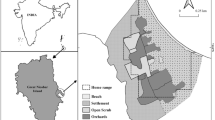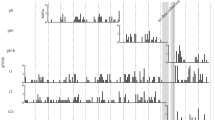Abstract
This article reports the structure of dominance and its relationship with social grooming in wild lion-tailed macaque females. The strength of dominance hierarchy was 0.79 on a scale of 0 to 1 indicating a moderate linearity in the ranking system. Dominance scores were converted into an ordinal as well as an interval scale. Grooming scores were also converted into interval scales using standard scores. Grooming received and grooming given correlated positively and negatively respectively with dominance ranks indicating that high ranking females received more and gave less grooming. Grooming was also positively related to encounter rates for dyads of females. More grooming among adjacent ranks, and grooming being more reciprocal, occurred only in the case of dominant females. The grooming patterns, therefore, appeared to be more of despotic than egalitarian nature. While ranking macaques into different Grades of social systems ranging from despotic to egalitarian, Thierry (2004) has placed lion-tailed macaques in Grade 3 corresponding to the ‘relaxed’ social system. Our results indicate that the grooming and dominance relationships in this species are more despotic, and hence, the Grade for this species requires to be shifted toward 2 or 1.
Similar content being viewed by others
References
de Waal F B M 1986 The integration of dominance and social bonding in primates;Q. Rev. Biol. 61 459–479
de Waal F B M 1991 Rank distance as a central feature of rhesus monkey social organization: A sociometric analysis;Anim. Behav. 41 383–395
de Waal F B M 1997 The chimpanzee’s service economy: food for grooming;Evol. Hum. Behav. 18 375–386
de Waal F B M and Luttrell L M 1986 The similarity principle underlying social bonding among female rhesus monkeys;Folia Primatol. 46 215–234
de Waal F B M and Luttrell L M 1989 Toward a comparative socioecology of the genusMacaca: Different dominance styles in rhesus and stumptail macaques;Am. J. Primatol. 19 83–109
Flack J C and de Waal F B M 2004 Dominance style, social power, and conflict management: A conceptual framework; inMacaque societies: A model for the study of social organization (eds) B Thierry, M Singh and W Kaumanns (Cambridge: Cambridge University Press) pp 157–181
Hemelrijk C K 2004 The use of artificial life-models for the study of social organization; inMacaque societies: A model for the study of social organization (eds) B Thierry, M Singh and W Kaumanns (Cambridge: Cambridge University Press) pp 295–312
Henzi S P and Barrett L 1999 The value of grooming to female primates;Primates 40 47–59
Jeyraj T 2003A study of male behavior in lion-tailed macaques (Macaca silenus) with special reference to male-male interactions, M.Sc. Dissertation, University of Mysore, Mysore
Keverne E B, Martensz N and Tuite B 1989 Beta-endorphin concentrations in cerebrospinal fluid of monkeys are influenced by grooming relationships;Psychneuroendocrinology 14 155–161
Kumar A 1987The ecology and population dynamics of the lion-tailed macaque (Macaca silenus) in south India, Ph.D. Dissertation,Cambridge University, Cambridge 377
Landau H G 1951a On dominance relations and the structure of animal societies: I, effect of inherent characteristics;Bull. Math. Biophys. 13 1–19
Landau H G 1951b On dominance relations and the structure of animal societies: II, some effects of possible social factors;Bull. Math. Biophys. 13 245–262
Landau H G 1953 On dominance relations and the structure of animal societies: III, the conditions for a score structure;Bull. Math. Biophys. 15 143–148
Melhman P T and Chapais B 1988 Differential effects of kinship, dominance and the mating season on female allogrooming in a captive group ofMacaca fuscata;Primates 29 195–217
Noe R E and Hammerstein P 1995 Biological markets;Trends Ecol. Evol. 10 336–340
Parr L A, Matheson M D, Bernstein I S, and de Waal F B M 1997 Grooming down the hierarchy: Allgrooming in captive brown capuchin monkeys,Cebus apella;Anim. Behav. 54 361–367
Prashanth U 2003A study of male behavior in bonnet macaques (Macaca radiata) with special reference to male-male interactions, M.Sc. Dissertation, University of Mysore, Mysore
Sade D S 1972 Sociometricsof Macaca mulatta. I. Linkages and cliques in grooming matrices;Folia Primatol. 18 196–223
Sakthivelou G and Kumar A 1998 Temporary group splitting in the lion-tailed macaqueMacaca silenus in a forest fragment in Indira Gandhi Wildlife Sanctuary, Tamil Nadu;J. Bombay Nat. Hist. Soc. 95 422–425
Seyfarth R M 1977 A model of social grooming among adult female monkeys;J. Theor. Biol. 65 671–698
Seyfarth R M and Cheney D L 1984 Grooming, alliances and reciprocal altruism in vervet monkeys;Nature (London) 308 541–543
Singh M, D’Souza L and Singh M 1992 Hierarchy, kinship and social interactions among Japanese monkeys(Macaca fuscata);J.Biosci. 17 15–27
Singh M, Kumara H N, Ananda Kumar M and Sharma A K 2001 Behavioral responses of lion-tailed macaque(Macaca silenus) to a changing habitat in a tropical rainforest fragment in the Western Ghats, India;Folia Primatol. 72 278–291
Singh M, Singh M, Kumar M A, Kumara H N, Sharma A K and Kaumanns W 2002 Distribution, population structure and conservation of lion-tailed macaque(Macaca silenus) in Anaimalai Hills, Western Ghats, India;Am. J. Primatol. 57 91–102
Singh M, Singh M, Kumara H N, Kumar M A and D’Souza L 1997 Inter- and intra-specific associations of non-human primates in Anaimalai Hills, South India;Mammalia 61 17–28
Singh M, Singh M, Sharma A K and Krishna B A 2003 Methodological consideration in measurement of dominance in primates;Curr. Sci. 84 709–713
Sushma H S 2004Resource utilization and niche separation in sympatric rainforest arboreal Mammals, Ph.D. Dissertation, University of Mysore, Mysore
Tanaka I and Takefushi H 1993 Elimination of external parasites (lice) is the primary function of grooming in free ranging Japanese macaques;Anthropol. Sci. 101 187–193
Sterck E H M, Watts D P and van Schaik C P 1997 The evolution of female social relationships in nonhuman primates;Behav. Ecol. Sociobiol. 41 291–309
Terry R L 1970 Primate grooming as a tension reduction mechanism;J. Psychol. 76 129–136
Thierry B 1985 Patterns of agonistic interactions in three species of macaques(Macaca mulatta, M.fascicularis, M. tonkeana);Agg. Behav. 11 223–233
Thierry B 2000 Covariation of conflict management patterns across macaque species; inNatural conflict resolution (eds) F Aureli and F B M de Waal (Berkley: University of California) pp 106–128
Thierry B 2004 Social epigenesis; inMacaque societies: A model for the study of social organization (eds) B Thierry, M Singh and W Kaumanns (Cambridge: Cambridge University Press) pp 267–289
Thierry B, Gauthoer C and Peignot P 1990 Social grooming in Tonkean macaques(Macaca tonkeana);Int. J. Primatol. 11 357–375
Thierry B, Singh M and Kaumanns W (eds) 2004Macaque societies: A model for the study of social organization (Cambridge: Cambridge University Press)
van Schaik C P 1989 The ecology of social relationship amongst females primates; inComparative socioecology: The behavioral ecology of humans and other animals (eds) V Standen and R A Foley (Oxford: Blackwell) pp 195–218
Author information
Authors and Affiliations
Rights and permissions
About this article
Cite this article
Singh, M., Krishna, B.A. & Singh, M. Dominance hierarchy and social grooming in female lion- tailed macaques (Macaca silenus) in the Western Ghats, India. J. Biosci. 31, 369–377 (2006). https://doi.org/10.1007/BF02704110
Received:
Accepted:
Published:
Issue Date:
DOI: https://doi.org/10.1007/BF02704110




